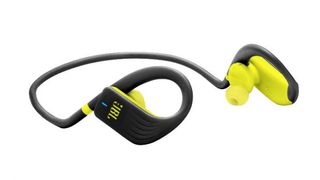You can trust Coach
Exactly what makes pair of sports headphones the right ones differs from person to person, a principle JBL has clearly embraced with the launch of its Endurance range. There are three sets of wireless headphones to pick from – Sprint (£44.99), Jump (£69.99) and Dive (£89.99) – with small differences between the trio.
The entire Endurance range is pretty cheap for wireless headphones, and the Sprint and Jump headphones even undercut our long-term favourite bargain set the Plantronics Backbeat FIT. Of course a bargain is only a bargain if the headphones actually work, and aside from a couple of annoying quirks the JBL Endurance Jump we tested delivered.

Those annoying quirks are almost all related to the Powerhook on the headphones. Something that hooks over the ear always helps with the fit, but here they form part of the mechanism to turn the headphones on and off. The ear-hook magnetically attaches to the headphones and when they are separated the headphones turn on. You fit them together again to turn the Jump headphones off.
At first, this seems like a clever little gimmick. It doesn’t seem all that useful an innovation, but fine. However, it loses its charm very quickly when the ear-hook separates from the headphone in your bag and automatically connects to your phone (try taking a call where the audio is going into a set of headphones in your bag). And it’s almost equally annoying when you pull out one headphone for a second and the ear-hook connects to turn them off. When working at its absolute best it’s a fundamentally pointless feature, and it’s just highly irritating when it isn’t.
Fortunately this Powerhook is the main difference between the Jump and Sprint headphones in the JBL range, so opt for the Sprint instead, saving yourself £25 and plenty of futile rage as you desperately hunt down headphones in your bag in order to hear what the person who called you is saying (“I understand that you’ve been in an accident that wasn’t your fault, is that correct?”). The Sprint has a magnetic hook on the headphones, but it doesn’t turn them on and off, which you do by holding a finger on a touch-sensitive panel for three seconds.
The Sprint, Jump and Dive headphones all offer the same sound quality, which is respectable considering the price. The bass isn’t especially powerful, and music gets slightly tinny and harsh at higher volumes, but it’s as good as anything I’ve heard on headphones around the £50-£80 mark.
You can improve the sound quality, especially the bass, by twisting the inner bud deep into your ear. However, this lessens the comfort of the headphones, which otherwise boast an excellent fit. The ear-hook ensures they don’t budge during strenuous exercise and the neckband sits close to your skin so it doesn’t flap around and pull the earbuds loose. It’s also better not to twist the buds right in so you can retain some awareness of the world around you when exercising outdoors.
The headphones are controlled by tapping or swiping on the panel that the buds and hooks attach to. I found this touchpad to be slightly hit and miss, often pausing music when I wanted to skip a track, and swiping up and down to increase and reduce volume was a bit of a faff. I fancy that button controls would be easier, but it’s not a huge issue.
See related

Battery life across the range is a decent eight hours, with ten minutes of charge yielding one hour of playback. The headphones are all waterproof and sweat-proof, and they come with a silicone carry case that does nothing to stop the damnable ear hook disengaging from the headphones in a bag.
While the Jump headphones don’t offer much beyond the Sprint apart from the Powerhook – the other upgrade is a more durable neckband – the Dive headphones are a bigger step up, containing 1GB of space for music. JBL is pitching this as especially useful for swimmers, who can’t take their phone into the water with them, but anyone who’d rather leave their phone behind when exercising will benefit.
The secure fit and low price of the headphones in the Endurance range make them an attractive option, and they also offer sound quality that I’d comfortably class as good enough for most people. I’d say the Jump is the least appealing option of the trio, while the Sprint really stands out as the best at £44.99 with no real loss in features compared with the Jump despite the significantly lower price. The Dive’s on-board music storage is a worthy upgrade for those who don’t want to take their phone with them when training.
JBL Endurance Sprint £44.99, buy on jbl.com. JBL Endurance Jump £69.99, buy on jbl.com. JBL Endurance Dive £89.99, buy on jbl.com.

Nick Harris-Fry is a journalist who has been covering health and fitness since 2015. Nick is an avid runner, covering 70-110km a week, which gives him ample opportunity to test a wide range of running shoes and running gear. He is also the chief tester for fitness trackers and running watches, treadmills and exercise bikes, and workout headphones.

This Expert PT Recommends Kettlebell Training For Strength, Power And Cardio Gains—And These Are The Six Exercises To Master First

I’ve Run The London Marathon Six Times—Here Are Four Ways To Set-Up Your Garmin Watch For A Better Race

Forget Crunches, This Exercise Is A Better Way To Build A Strong Core
